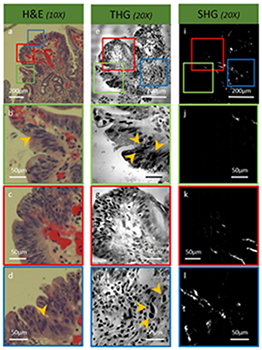 My research interest is in the discovery of novel imaging techniques and instruments for the detection and treatment of cancer and other disorders of the digestive organs. The research truly is multi-disciplinary and brings together faculty and students from diverse fields, including those represented by the UA College of Optical Sciences; Departments of Biomedical Engineering, Molecular and Cellular Biology, Chemistry and Biochemistry, and Medical Imaging; and Division of Gastroenterology and Hepatology. Our research has led to exciting new discoveries and formed the basis of PhD and MS dissertations for students from the College of Optical Sciences and Department of Biomedical Engineering. A common theme in my research is to develop methods of disease detection and treatment in real-time that can be used at the point-of-care, without the use of dyes or stains (label-free).
My research interest is in the discovery of novel imaging techniques and instruments for the detection and treatment of cancer and other disorders of the digestive organs. The research truly is multi-disciplinary and brings together faculty and students from diverse fields, including those represented by the UA College of Optical Sciences; Departments of Biomedical Engineering, Molecular and Cellular Biology, Chemistry and Biochemistry, and Medical Imaging; and Division of Gastroenterology and Hepatology. Our research has led to exciting new discoveries and formed the basis of PhD and MS dissertations for students from the College of Optical Sciences and Department of Biomedical Engineering. A common theme in my research is to develop methods of disease detection and treatment in real-time that can be used at the point-of-care, without the use of dyes or stains (label-free).
Current research projects include:
- Receptor-targeted imaging of surgical margins using microbubbles and multi-photon microscopy (MPM). Microbubbles used for intra-vascular ultrasound contrast are decorated with ligands for attachment to receptors on tumor cells. Multi-photon imaging (MPI) is used to visualize the attachment of microbubbles to unseen cancer cells. Optical coherence tomography (OCT) will be used for sub-surface imaging.

- Label-free MPI of Barrett’s esophagus to display high resolution histology and simultaneous, selective, quantifiable imaging of sub-epithelial collagen with the goal of developing a portable, point-of-care diagnostic device for in-vivo, real-time diagnostics. Read more...
- Fluorescence imaging of neoplasms of the colon. Fluorescence images are processed using formulae that represent structural and functional changes in neoplasia, leading to extraordinary levels of contrast that should improve lesion detection. Read more...
- Label-free imaging of mucosal eosinophils with applications in esophageal and other disorders.
- Omni-directional imaging: Construction and testing of optical probes and endoscopes based on a novel technology that allows one to see forwards and backwards in 360 degrees, at the same time and in one image. Read more...


